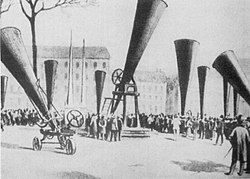


A hail cannon is a shock wave generator claimed to disrupt the formation of hailstones in the atmosphere.
Contents
These devices frequently engender conflict between farmers and neighbors when used, [1] because they are loudly and repeatedly fired every 1 to 10 seconds while a storm is approaching and until it has passed through the area, yet there is no scientific evidence for their effectiveness. [2]